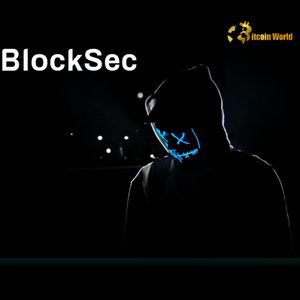BitcoinWorld BlockSec Issues Urgent Warning After Usual Protocol Hack In the fast-paced world of decentralized finance (DeFi), security remains a paramount concern. The recent news regarding the Usual protocol highlights the constant vigilance required to protect digital assets. A prominent blockchain security firm, BlockSec , recently announced that its sophisticated monitoring systems detected an exploit targeting the Usual stablecoin protocol. What Happened with the Usual Protocol ? According to an announcement made by BlockSec on the social media platform X, their real-time detection systems flagged suspicious activity on the Usual protocol . This decentralized stablecoin platform aims to offer users a stable digital asset, but like many protocols, it faces potential vulnerabilities. Following BlockSec ‘s alert, the team behind the Usual protocol took swift action and temporarily paused the protocol. This measure is often a critical first step when a potential exploit is detected, allowing developers time to investigate the issue, assess the damage, and formulate a plan for recovery and patching without further funds being put at risk. Details regarding the specific nature of the exploit were not immediately available in the initial announcement. However, the fact that a security firm’s automated system could detect the attack underscores the evolving landscape of blockchain security . How Did BlockSec Detect the Attack? BlockSec stated that the detection was made possible by their Phalcon platform. Phalcon is described as a system offering real-time attack detection and automated response features. This type of technology is becoming increasingly vital in the DeFi space, where exploits can happen in minutes, or even seconds, leading to significant financial losses before manual intervention is possible. The capabilities highlighted by BlockSec include: Real-time Monitoring: Continuously watching transactions and contract interactions on the blockchain. Attack Pattern Recognition: Identifying known or novel exploit techniques as they occur. Automated Response: Potentially triggering pre-defined actions, such as alerting the protocol team or even interacting with the contract (if designed to do so safely) to mitigate damage. The detection of the exploit on the Usual protocol serves as a practical example of how proactive security monitoring tools can play a crucial role in minimizing the impact of a crypto hack . Understanding Blockchain Security Challenges The incident with the Usual protocol is a stark reminder of the inherent challenges in maintaining robust blockchain security . Decentralized protocols, especially those involving complex smart contracts like stablecoin protocol s, are attractive targets for malicious actors. Common vectors for a crypto hack include: Smart Contract Vulnerabilities: Bugs or logic errors in the code that can be exploited. Flash Loan Attacks: Utilizing uncollateralized loans to manipulate asset prices or protocol logic within a single transaction. Oracle Manipulation: Feeding false price data to the protocol. Governance Attacks: Exploiting governance mechanisms to approve malicious proposals. Economic Exploits: Finding ways to profit by interacting with the protocol in unintended ways based on its economic design. Ensuring comprehensive blockchain security requires multiple layers of defense, including rigorous smart contract audits, formal verification, bug bounty programs, and continuous real-time monitoring by platforms like BlockSec’s Phalcon. The Impact of a Crypto Hack on Protocols and Users When a crypto hack occurs, the consequences can be severe for both the protocol and its users. For the Usual protocol , the immediate impact is the temporary pause, which disrupts its normal operation and can cause uncertainty among users holding or using the USUAL token. For users, the primary concern is the safety of their funds. While the pause helps prevent further losses, the fate of funds potentially affected by the exploit remains a critical question that the Usual team will need to address after their investigation. A crypto hack erodes trust in the affected protocol and can have a ripple effect on the broader DeFi ecosystem, reminding participants of the risks involved. The incident also highlights the importance of transparency and communication from the protocol team during a security event. Timely updates on the investigation and recovery plan are essential for managing community expectations and maintaining confidence. Protecting Your Investments in a Stablecoin Protocol Given the risks highlighted by events like the one affecting the Usual protocol , what steps can users take to protect their investments, especially within a stablecoin protocol ? Due Diligence: Research the protocol thoroughly. Understand its mechanism, especially how the stablecoin maintains its peg. Audit Reports: Check if the protocol has undergone security audits by reputable firms. Read the reports and understand the findings. Team Reputation: Look into the experience and reputation of the development team. Monitoring & Alerts: Follow the protocol’s official communication channels and security firms like BlockSec for real-time updates and alerts. Diversification: Do not put all your funds into a single protocol, no matter how safe it seems. Understand the Risks: Be aware that even audited and monitored protocols can face unforeseen vulnerabilities. Investing in DeFi, including stablecoin protocol s, involves risk. While security tools are improving, user vigilance remains a key component of safety. The detection of the exploit on the Usual protocol by BlockSec ‘s Phalcon platform is a significant event, showcasing both the persistent threat of a crypto hack in the DeFi space and the increasing sophistication of blockchain security tools designed to combat them. The temporary pause of the Usual protocol was a necessary step to contain the situation. As the investigation unfolds, the community will be watching for details on the exploit and the protocol’s plan for moving forward. This incident serves as a crucial reminder for all participants in the decentralized ecosystem about the importance of continuous security monitoring, robust protocol design, and user awareness. To learn more about the latest crypto security trends, explore our article on key developments shaping DeFi security measures. This post BlockSec Issues Urgent Warning After Usual Protocol Hack first appeared on BitcoinWorld and is written by Editorial Team
















